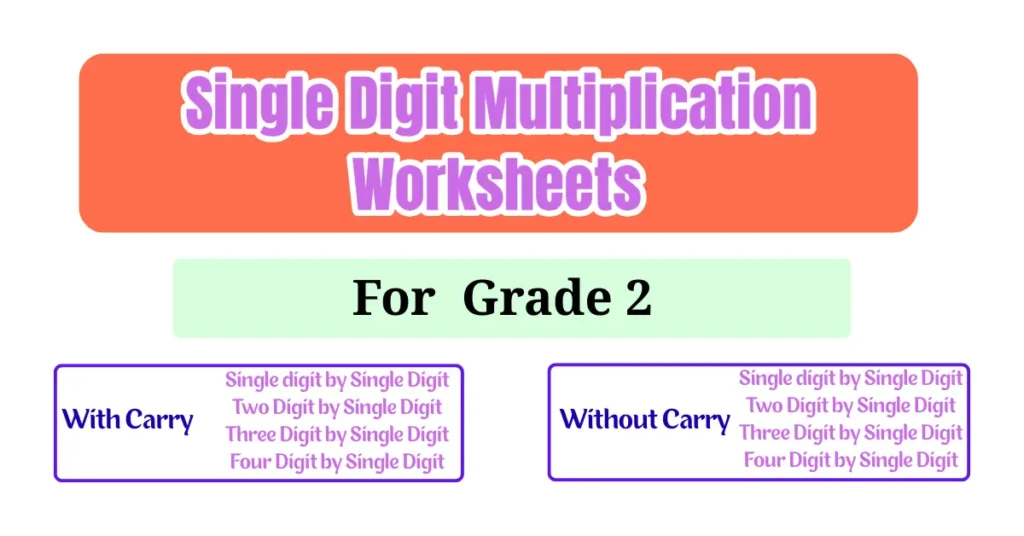
Single Digit Multiplication Worksheets contains multiplication problems of a single digit by another single digit. Your child can do these easily if he or she has learned the times table up to 10 as they involve one-digit multiplication.
Here is link from wikipedia to know more about multiplication.
And watch this YouTube video for more clarity
Table of Contents
Single Digit Multiplication Worksheets for Grade 2
The multiplication worksheets are designed for students in the 2nd grade. The worksheets will consist of four types of questions:
- The multiplication of a single-digit number by a single-digit number
- The multiplication of a two-digit number by a single-digit number
- The multiplication of a three-digit number by a single-digit number
- The multiplication of a four-digit number by a single-digit number
Worksheets on the Multiplication of Single-Digit Numbers by Single-Digit Numbers
Single Digit multiplication worksheets are specifically designed to help students practice and enhance their multiplication skills by focusing on problems that involve multiplying a one-digit number by another one-digit number. Each worksheet is filled with a variety of exercises that challenge students to apply their knowledge of basic multiplication facts.
The problems range from simple, such as 2 × 3 or 4 × 5, to more complex combinations like 7 × 8 or 9 × 6. This variety helps reinforce fundamental multiplication concepts while also encouraging quick recall and mental calculation skills.
Additionally, these worksheets are suitable for early learners who are just beginning to understand multiplication, as well as for older students who need extra practice to build confidence and accuracy. They can be used both in classroom settings and at home for additional practice.
Download our Single-Digit Multiplication Worksheet 1 for grade 2
Download our Single-Digit Multiplication Worksheet 2 for grade 2
Download our Single-Digit Multiplication Worksheet 3 for grade 2
Download our Single-Digit Multiplication Worksheet 4 for grade 2
Download our Single-Digit Multiplication Worksheet 5 for grade 2
Download our Single-Digit Multiplication Worksheet 6 for grade 2
Worksheets on the Multiplication of Two-digit numbers by Single-Digit numbers
Single Digit Multiplication worksheets are designed to help students practice and master the fundamental skill of multiplying two-digit numbers by a single-digit number. These worksheets are structured to cover two main types of problems to provide comprehensive learning and practice opportunities.
Single Digit Multiplication Worksheets Involving Carrying: (2-digit numbers by 1-digit numbers)
In these types of worksheets, the single digit multiplication results in a product where the value in one of the place columns exceeds nine, requiring students to carry over the extra value to the next column. This helps students understand the concept of place value and reinforces their addition skills alongside multiplication.
Download our 2-digit by 1-digit Multiplication Worksheet 1 for grade 2
Download our 2-digit by 1-digit Multiplication Worksheet 2 for grade 2
Download our 2-digit by 1-digit Multiplication Worksheet 3 for grade 2
Download our 2-digit by 1-digit Multiplication Worksheet 4 for grade 2
Download our 2-digit by 1-digit Multiplication Worksheet 5 for grade 2
Download our 2-digit by 1-digit Multiplication Worksheet 6 for grade 2
Download our 2-digit by 1-digit Multiplication Worksheet 7 for grade 2
Single Digit Multiplication Worksheets Without Carrying: (2-digits numbers by 1-digit numbers)
These worksheets are simpler as the multiplication of digits results in products that do not exceed nine, eliminating the need to carry over to the next column. This type is ideal for beginners who are just getting familiar with the concept of multiplication.
By working through both types of problems, students can develop a strong foundation in multiplication, improve their numerical fluency, and gain the confidence needed to tackle more complex mathematical operations in the future.
Worksheets on the Multiplication of Three-digit numbers by Single-Digit numbers
After successfully completing the above-mentioned worksheets, the students of Grade 2 will be well-prepared to tackle more challenging mathematical problems, specifically those involving the multiplication of 3-digit numbers by single-digit numbers. This progression not only reinforces their understanding of basic multiplication concepts but also builds their confidence in handling larger numbers.
These new exercises are designed to be highly beneficial, as they offer ample practice opportunities that help students master the techniques of simple digit multiplications. Through repeated application and problem-solving, students will develop strong foundational skills necessary for more advanced mathematical concepts in the future. Additionally, these activities promote critical thinking, enhance problem-solving abilities, and improve calculation speed and accuracy, all of which are essential components of mathematical proficiency.